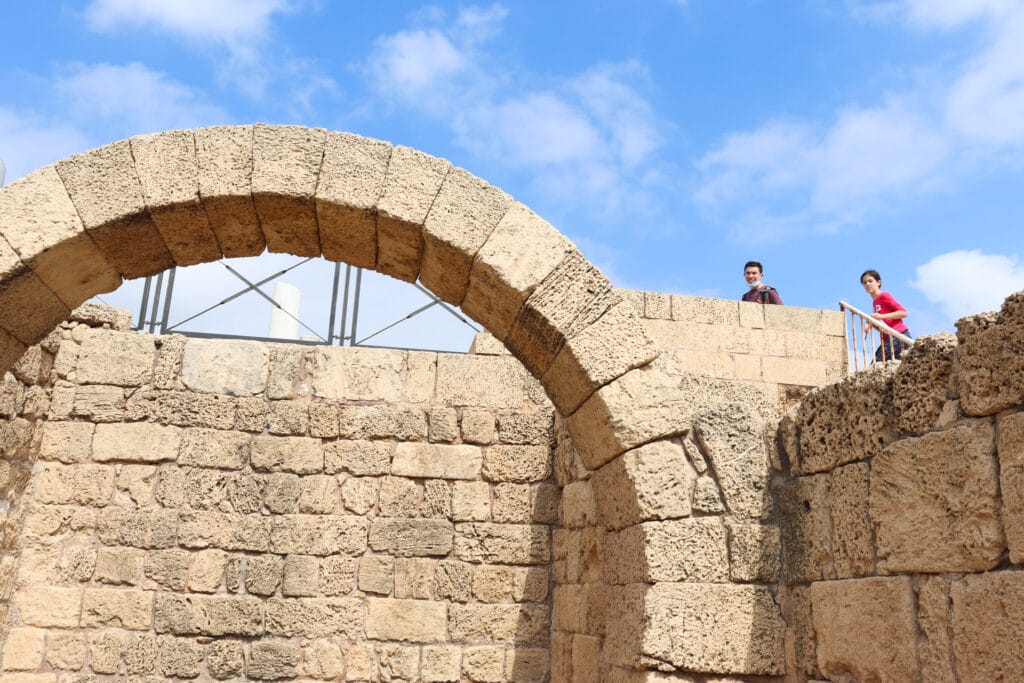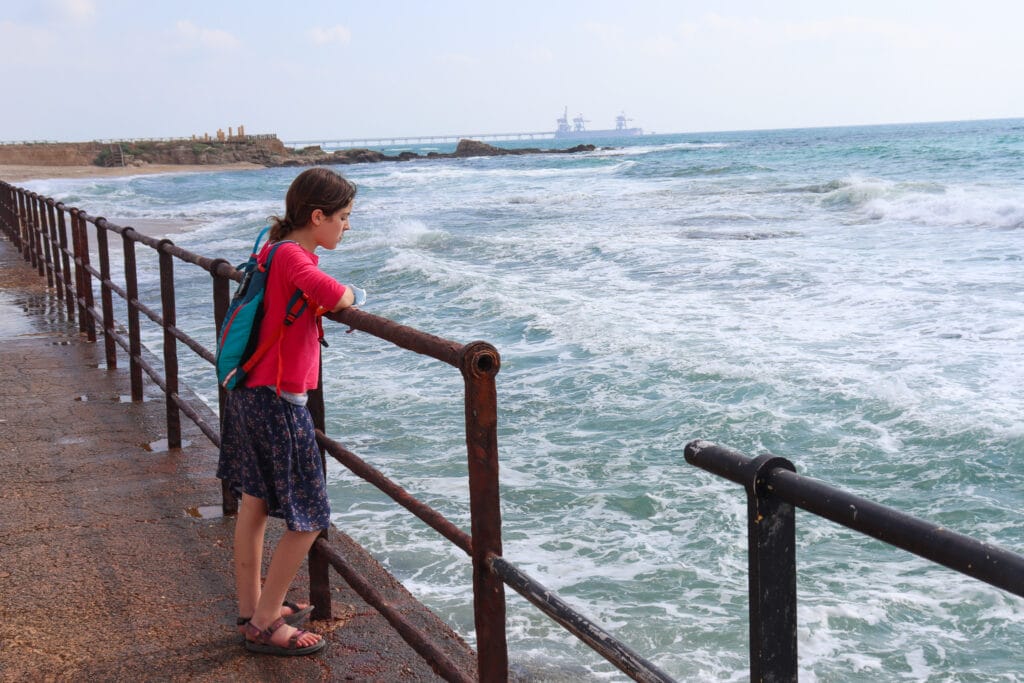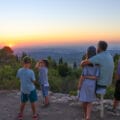
| Distance: <1km | Time: 2 hours | Difficulty: Easy |
| Ascent: 20m | Trail Map | Terrain View |
Click here to go straight to hike notes.
Caesarea: this luxurious beachside city is known for its manicured lawns, mansions, and golf clubs. But once upon a time (like 2000 years ago), Caesarea was a model city of a different sort.
Instead of movie theatres there was a gladiator stadium. Instead of playing golf, people raced chariots for sport. And rather than take a good soak in the backyard pool, Caesarea’s ancient citizens made use of the large and beautiful bathhouse, complete with intricate mosaic floor.
Nowadays, ancient Caesarea is one of the coolest archeological excavations in the country. The port-city is well preserved and impressive. And since it’s also a National Park, time and effort has been put into creating displays and a museum that give a full picture of life in ancient Caesarea over the years.

We made our way to Caesarea last week, after a trip to our local ancient palace (Herodion) left us hungry for more information about King Herod’s creations.
Walking through the National Park at a lazy pace, I can’t really call the walk we took at Caesarea a hike. But it was a fascinating outdoor exploration of history overlooking one of Israel’s beautiful beaches.
Here’s how we discovered sand, sea, and an ancient city at Caesarea National Park:
Through the Palace Gates
There are several entrances into Caesarea National Park – the one we went through was quiet, with no gift shop, and more disappointingly, no Junior Ranger booklets! Instead, we got maps in English and Hebrew, and proceeded through a fully intact arched gateway built as part of the ancient city.

Once inside the National Park, we were slightly disoriented. On one side, there was a replica of an ancient pond, with Roman statues and pillars. On the other side, there was a grassy area. And right up ahead lay a series of cute restaurants, overlooking the seashore.
We checked our map and planned out our route. First, we would walk along the sea, passing some antiquities on the way, as we approached the new visitor’s center. I always feel that a trip to a visitor’s center is the best way to begin a journey of this kind – it’s better to know the backstory before you explore.
Bringing History Alive
It was hot, sunny, and humid that day. The breeze from the sea didn’t do much to cool us down. So, we were relieved to enter the cool confines of the museum.

Once inside, the guard checked our tickets and explained what we would see. The visitor’s center is divided into four amazing rooms. After exploring the first two, we’d enter a theatre where we could watch a movie in English or Hebrew.
Inside, an array of ancient artifacts greeted us, all preserved under artificial lighting in the cool, enveloping darkness. We saw shiny, gold coins from many different eras – Caesarea was an important city even after the Roman empire fell, used by locals over the years. An old anchor sat on display, along with ancient pottery and pieces of pillars discovered at the site.

After looking through all of the displays, we headed into the theatre – complete with stadium seating and a giant screen.

Herod, the King
As opposed to the movie on our previous week’s journey to Herodion, this short film focused more on the life of Herod the King. We discovered that Herod was a bold but controversial king, who in his quest for power, had several family members killed. The construction of the city of Caesarea took years and years to complete, and it was considered to be one of the jewels of the Roman Empire.

After the movie, we headed towards the final room of the museum. Using cool effects, the displays in the last room brought history to life.
We emerged from the visitor’s center into the sunshine, ready to explore the rest of the park.
Artifacts and Antiquities
Now that we knew a bit more about the history of Caesarea, we had a better understanding of all of the ancients sights we saw.

We explored the bathhouse, complete with an intricate mosaic floor (which sort of reminded me of a 1980’s era swimming pool). Marble columns and pillars laid overturned in all locations. It was as if the city had been recently destroyed.
My kids loved climbing over stone archways and balancing on carved columns. We climbed up and down several sets of stone steps. There was a lot to explore.

Afterwards, we headed down to the racetrack, where horse drawn chariots used to compete as citizens watched from stadium seating. The seating was just like it would be in modern times – and we could imagine how impressive it once was to watch a horserace with an incredible view of the sea just beyond the track.
Always Better with a Beach
From here, we proceeded towards the boardwalk and the beach. Droplets of salt water sprayed in our faces as we looked out over the Mediterranean.
The view out to the structures of Caesarea from the shore was impressive – Herod had built up the coast in a semicircle, jutting out into the water from both sides.

We didn’t actually go into the water (no lifeguards here), but we did enjoy the feel of sand at our feet and the saltwater taste on our tongues. From the beach, we headed back towards the main area of the National Park where we took one last walk along the boardwalk.
When all was said and done, Caesarea National Park was a great place to visit. If we had wanted to spend more time, we would have stopped at one of the restaurants and enjoyed a quiet meal and a tall glass of beer by the beach (like the rest of the park’s visitors).
But we were moving on to the next great adventures of the day: a waterfall walk, dinner at a winery, and sunset on a beautiful beach. It was time to say goodbye to Caesarea.
We left King Herod’s city through intricate arches, satisfied that we had learned a bit more about one time period in Israel’s rich and fascinating history.


Hikers’ Notes:
Here’s what you need to know to visit Caesarea National Park:
- This “trail” is suitable for all seasons. It can be hot and sunny in the summertime, so come prepared with a hat, sunscreen, and water.
- Great for kids.
- No dogs allowed.
- Swimming on this beach is not allowed (but we did see a few kids playing in the water!). There is a beach for swimming right nearby.
- Since this is a National Park, you will need to use your Parks Card or pay an entrance fee to get in. Maps and facilities are available on site.
- Turn a visit to Caesarea into a full day adventure: hike in the water at Ein Aviel after this. Then get dinner at the amazing Tishbi Winery. Finish the day with sunset at Dor HaBonim Beach.
Questions? Have you been to ancient Caesarea? Let’s hear about it in the comments!







Hello, can you tell me how to find a list of the sites with Junior ranger booklets and pins?
thank you!
https://www.parks.org.il/files/ranger/